Ever dedicated a day to exploring the fascinating world of Montana’s own animal kingdom? If you haven’t, you’re missing out on a wild adventure through the lush habitats and diverse critters at ZooMontana, and other captivating Montana zoos. Buckle up, because this guide is about to take you on a roaring journey!
So who will find this article intriguing? Well, if you’re an animal lover, a family looking for an enjoyable day out, a local intimately connected to Montana, or a tourist yearning for something different, you’ve struck gold.
This guide will not only navigate through the captivating exhibits of ZooMontana but also lead you to other hidden gems in the world of Montana zoos. From understanding the ecosystems at play to tips on making the most of your visit, you’re set for a thrilling ride.
- Related article: Best Montana Tourist Attractions
So, if you’re as curious as a cat, ready to soak up new knowledge like a sponge, harness that inner wildlife enthusiasm and read on. Buckle up, the expedition is just beginning!
7 Key Takeaways on ZooMontana and Other Montana Zoos
- More than just a zoo, ZooMontana boasts a zoological and botanical garden that is home to over 100 animals from 51 different species. With a focus on rescue animals, education, and community support, it’s an adventure waiting to happen.
- Divided into Asia and North America regions, visitors can enjoy interactive experiences and scenic nature trails that offer close encounters with animals like wolves, grizzly bears, and majestic red pandas.
- The Sensory Garden and the recently added Yellowstone Arboretum offer one-of-a-kind botanical experiences that complement ZooMontana’s animal attractions and focus on conservation.
- ZooMontana’s dedicated preschool program provides an early educational experience for children, combining classroom learning with wildlife exploration.
- This establishment within ZooMontana focuses on wildlife conservation, including the development and distribution of a wildlife contraceptive vaccine, highlighting ZooMontana’s commitment to animal welfare on a global scale.
- Welcoming over 100,000 visitors annually and impacting the lives of 12,000 students, ZooMontana’s educational initiatives, community support, and ongoing exhibit innovation showcase a deeply rooted commitment to environmental awareness and conservation.
- ZooMontana isn’t just a collection of animals in cages; it’s a sanctuary, a classroom, and a living tribute to the natural world. With unique educational programs, commitment to animal welfare, and seamless integration of botanical elements, it’s a must-visit for both locals and tourists.
About ZooMontana
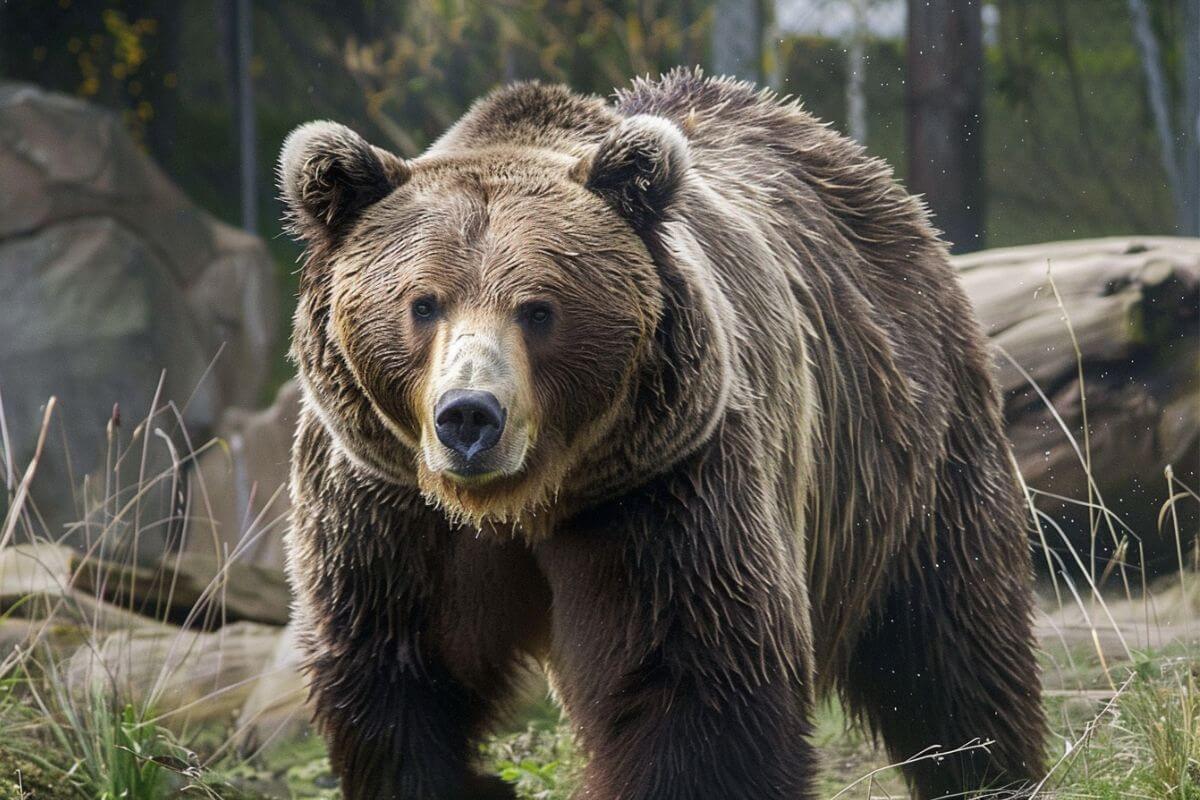
Let’s talk about majestic grizzly bears, playful otters, soaring eagles, and the whole furry family at ZooMontana. This isn’t your typical zoo, no sir, it’s a zoological and botanical garden nestled north of Yellowstone and right on the 45th parallel in Billings, Montana.
As zoos go, ZooMontana stands out, showcasing over 100 animals from 51 different species, and a cool unique selling point. Many are rescues, with an emphasis on conservation and care. I was incredibly mesmerized by the wolves and lynx. It’s pretty much one of Big Sky State’s amusement parks for animal lovers.
Now, if I were you, of course, I’d love to brag about living in the same city as ZooMontana — Billings, MT where it’s located, but the truth is, it’s a nugget of treasure awaiting to be discovered for any tourist too. The scenic backdrop of the Beartooth Mountains plays the perfect supporting act, just saying.
What tugs at my heartstrings about ZooMontana is their deep dive into education. They don’t just hand you a brochure, nope. The zoo offers unique educational opportunities like direct observation, interpretive displays, and hands-on programs.
Let’s zoom out (see what I did there?) and look at the grand scheme of things. ZooMontana packs an annual punch, welcoming over 100,000 visitors, many of whom are northern Rockies residents.
And let’s not forget the kiddos — with community and educational programs that serve over 12,000 students, the zoo is planting more than just pretty flowers. Plus, they’re right at the heart of Montana’s zoo events, which bring in money to help care for their animals.
The unsung heroes of ZooMontana? They’re the 16-member staff and army of volunteers who keep the furry, feathery, and scaly inhabitants in good spirits. The community support, in the form of donations and outreach, is like a big Montana hug — solid, heartwarming, and always there when you need it.
From its carefully curated animal habitats to its earnest conservation efforts, ZooMontana is not just a zoo but a compelling story of community, education, and undying love for our animal friends.
Animal Exhibits
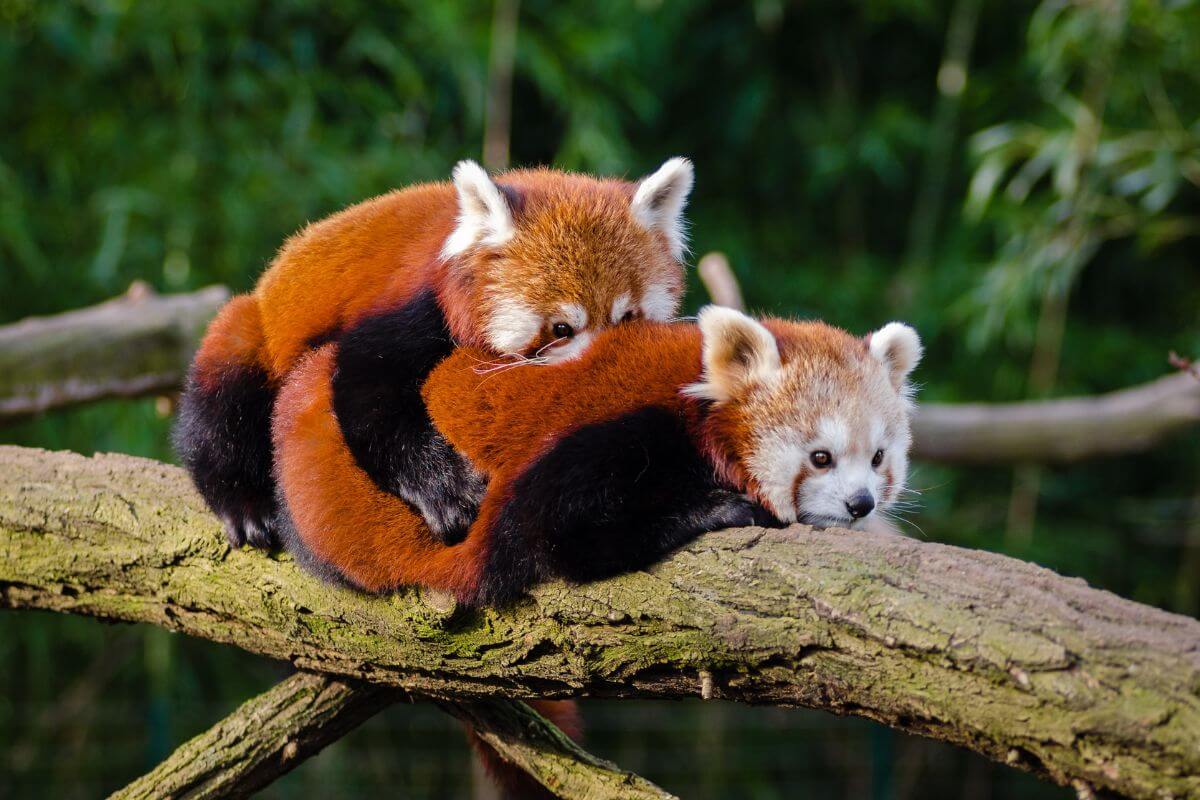
ZooMontana is a haven for both native and exotic animals, thoughtfully sculpted to mirror their natural habitats. Divided into two distinct regions, this is more than your ordinary zoo. It’s an adventure waiting to happen!
Asia Region:
- Animal Neighborhood – wolves, a Siberian tiger, and the charismatic red panda.
- Scenic Nature Trails – Meander through a picturesque cottonwood forest.
- Insider tip – Take the paved path to the left for a thrilling encounter with the regal Siberian tiger, or opt for the right to meet the adorable red panda.
North America Region:
- Meet & Greet – Wolves, grizzly bears, bighorn sheep, river otters, and even the iconic bald eagle.
- Interactive Experiences – “Fishing with the otters was fun, and watching the bald eagle in what’s essentially its ‘backyard’ was breathtaking,” shared Sara, a young visitor.
- Wildlife Showcase – From South America to Africa, encounter a diverse range of critters, like iguanas, minks, and chinchillas.
- Animal Encounters – Feed the koi, and take a closer look at the majestic Belgian draft horses and pygmy goats at The Barn.
Since 2016, ZooMontana has opened new exhibits featuring takin, wolverines, American bison, and raptors. It’s truly a place of wonder and amazement for all animal lovers. Remember to check the feeding schedules and interactive experiences to maximize your visit.
Botanical Gardens
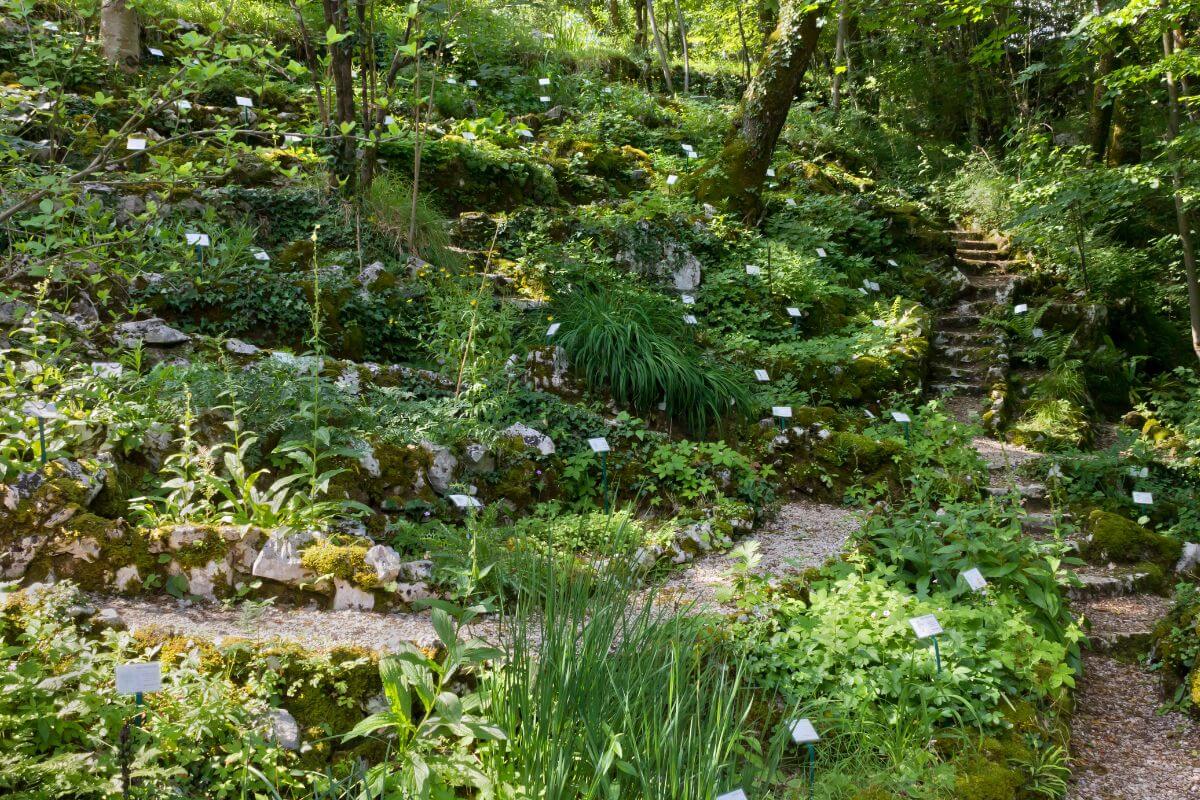
This 1-acre paradise showcases a stunning array of native and exotic plants, inviting visitors to engage their senses in a truly immersive experience. The garden’s serene environment is a testament to the zoo’s commitment to local flora and fauna, providing an educational and tranquil retreat for those looking to learn about Montana’s botanical diversity.
In 2018, the establishment of the Yellowstone Arboretum expanded ZooMontana’s botanical offerings, featuring a diverse collection of native and non-native trees. This addition not only enhances the recreational experience for visitors but also provides an educational opportunity to learn about the region’s unique plant life.
ZooMontana’s botanical park plays a critical role in its mission to inspire and educate visitors about the natural world. By integrating animal exhibits with botanical gardens, the zoo offers a comprehensive view of ecosystems, fostering a deeper appreciation for wildlife conservation and highlighting the crucial role of plant life in these environments.
A visit to ZooMontana’s botanical gardens is a journey that promises to captivate and educate visitors, allowing them to truly connect with nature.
ZooSchool Preschool

Located in Billings, Montana, ZooMontana offers a unique preschool program called ZooSchool, catering to children aged 3, 4, and 5. Led by certified teacher Marnie Emond, ZooSchool provides an exceptional educational experience for young learners. Marnie holds a Master’s Degree in Education and has over twelve years of experience in teaching preschool children.
At ZooSchool, children have the opportunity to learn about animals, interact with zookeepers, and participate in behind-the-scenes activities, creating a hands-on and immersive learning environment.
The curriculum covers a wide range of topics, including the alphabet, colors, and numbers, while also emphasizing parental involvement. Each child is required to have a parent helper in the preschool classroom for one class time each, enhancing the overall learning experience.
With a maximum enrollment of 12 students per class, ZooSchool ensures individualized attention and a supportive learning environment.
For parents interested in enrolling their children, new student registration typically begins in March for the following school year. ZooSchool is located at 2100 S. Shiloh Road in Billings, Montana, offering a one-of-a-kind preschool experience for young children.
Science and Conservation Center
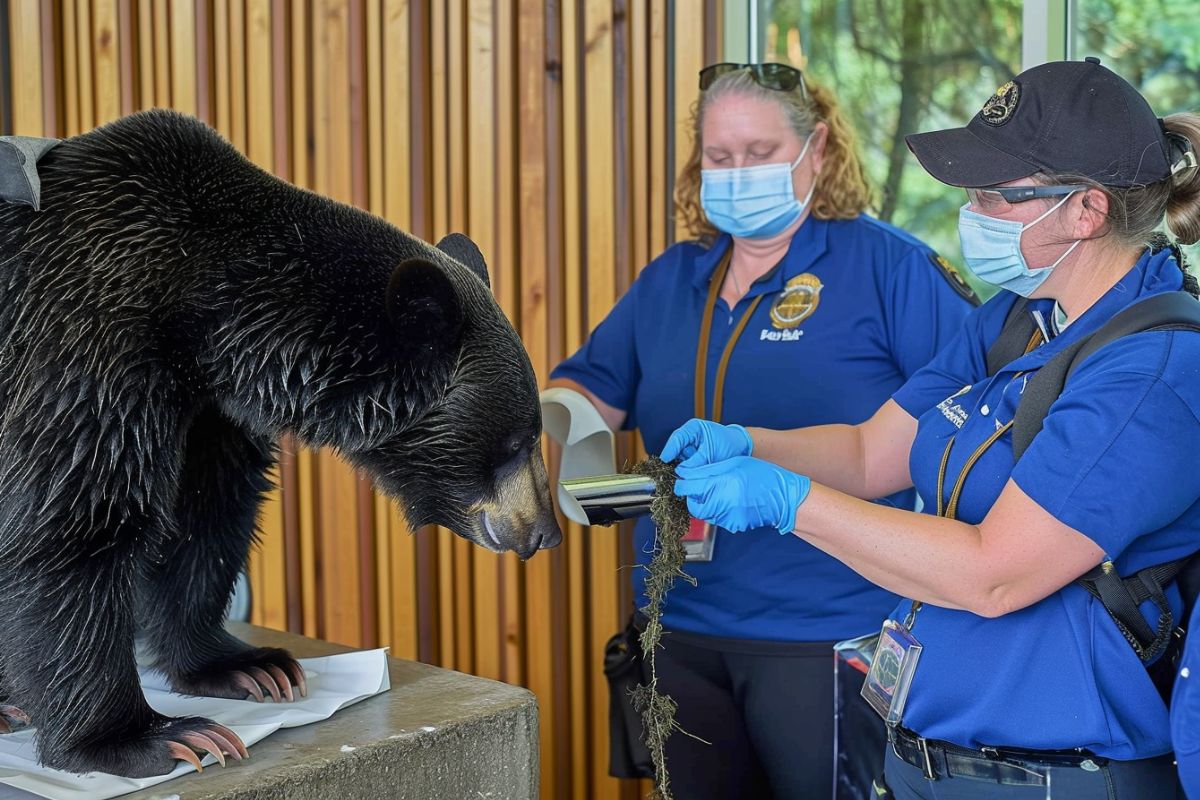
The Science and Conservation Center is an independent non-profit organization based within the zoo dedicated to the preservation of wildlife. One of their notable initiatives includes the production and distribution of a wildlife contraceptive vaccine, with the responsibility of maintaining records and data required by the Food and Drug Administration.
Their collaboration with the Contraception Advisory Group of the AZA at the Saint Louis Zoo is impressive, highlighting their coordination and, in some cases, the execution of contraceptive applications to wildlife.
ZooMontana’s commitment to wildlife conservation extends throughout Montana and the 45th parallel, where they care for over 80 animals of 56 different species, including Amur Tigers, Grizzly Bears, Wolverines, River Otters, and Takin. It’s truly inspiring to see their dedication to the preservation of these remarkable species.
Other Zoos in Montana
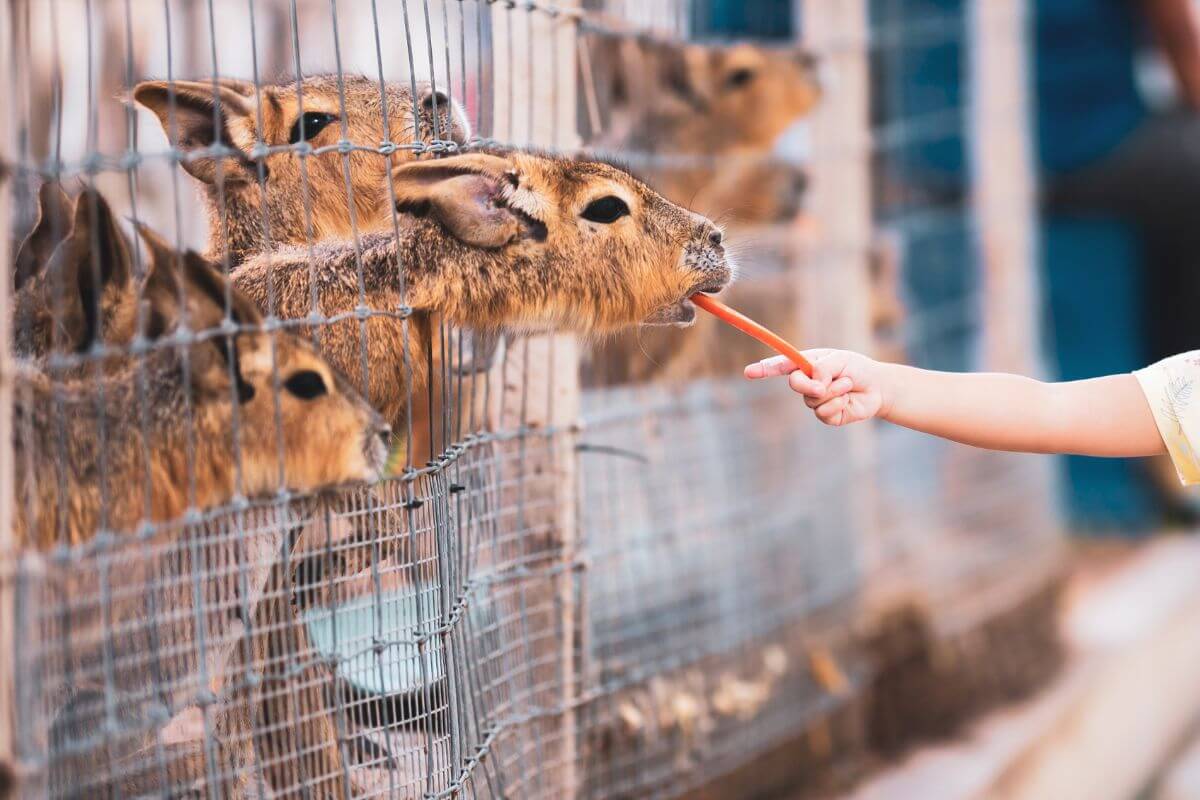
In Montana, beyond traditional zoos, several unique venues offer opportunities to observe and interact with both land and marine animals. Here’s a list of non-traditional places where you can see a variety of animal exhibits.
1. Grizzly & Wolf Discovery Center
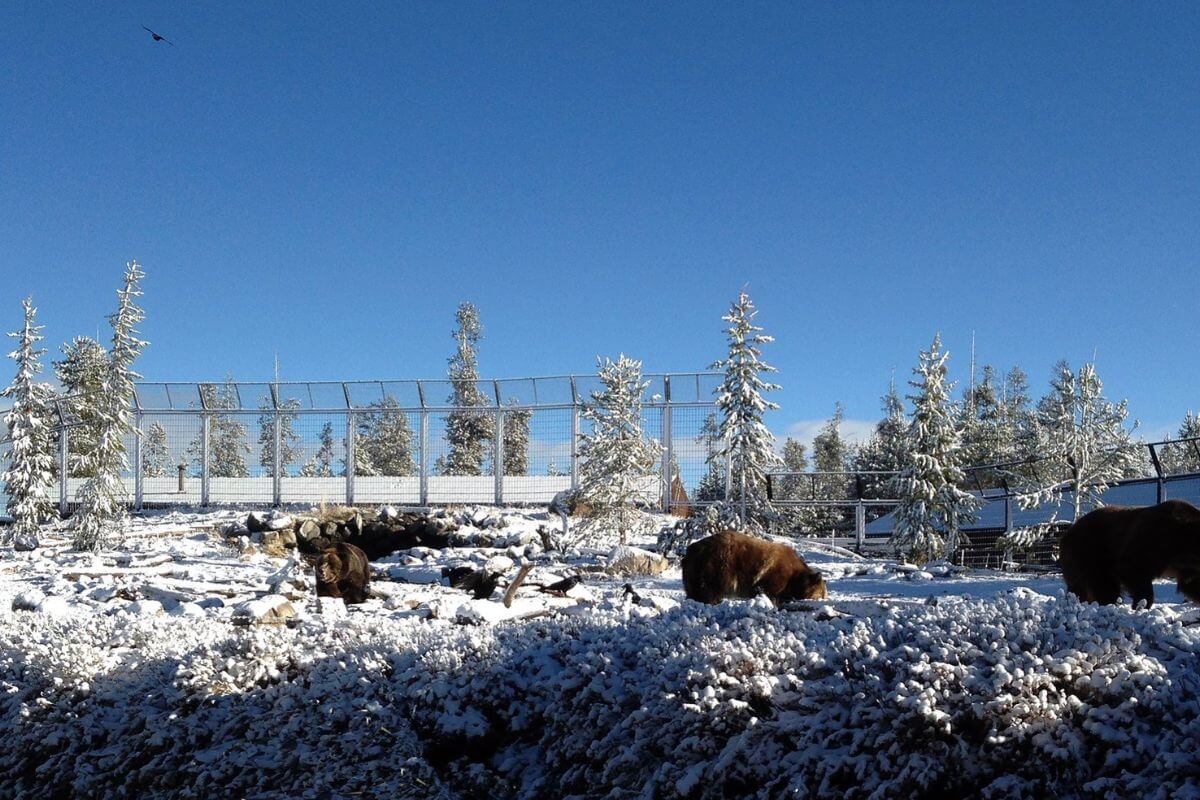
The Grizzly & Wolf Discovery Center, nestled in West Yellowstone, Montana, is a not-for-profit wildlife park and educational facility where visitors can marvel at live bears and wolves in naturalistic habitats.
Among the diverse wildlife dwelling here, you’ll encounter Siberian tigers, river otters, ferrets, gray wolves, deer, waterfowl, and a variety of owls and eagles, just to name a selection.
The center provides a home for grizzly bears unable to survive in the wild, including orphaned cubs and those too accustomed to human presence. These majestic creatures serve as ambassadors for their species, offering insight into the challenges facing wild grizzly populations.
It also has a naturalistic outdoor habitat for the wolves, which includes tall grass, logs, trees, and a pond with a waterfall, giving the wolves a comfortable and natural home.
Captive-born grey wolves at the center have formed two distinct packs, allowing visitors a rare opportunity to observe their strong family structures and intricate social dynamics.
The center also features an exhibit called the Banks of the Yellowstone River Otter Exhibit, which showcases North American river otters in a simulated riparian habitat. When you visit, you can explore a Yellowstone riparian habitat next to simulated ponds, streams, and waterfalls, learning about the diverse wetlands and their interconnected ecosystems.
Through these encounters, the center fosters appreciation and understanding of these iconic North American predators while promoting their conservation in the wild.
2. Yellowstone Wildlife Sanctuary
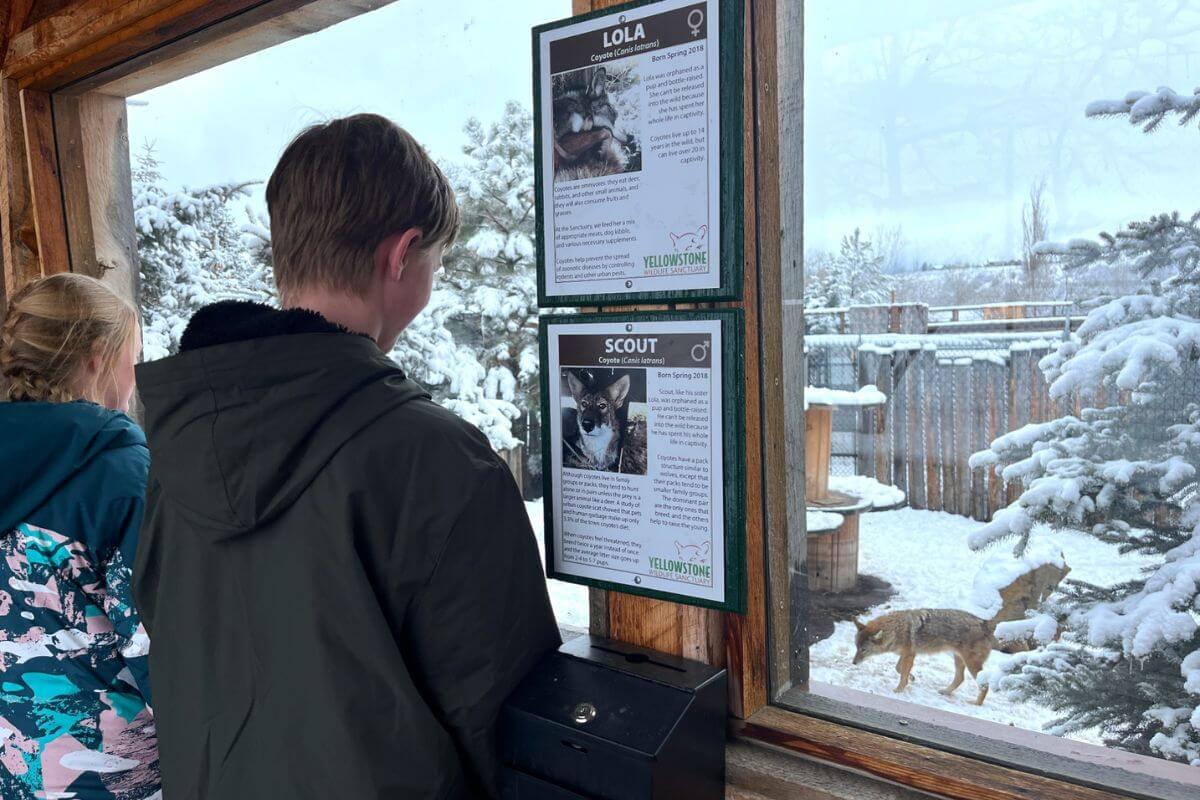
The Yellowstone Wildlife Sanctuary, located in Red Lodge, Montana, is a nonprofit organization dedicated to providing lifelong sanctuary to non-releasable native Montana wildlife while prioritizing education and conservation efforts.
The sanctuary houses a diverse array of animals, including black bears, gray wolves, coyotes, red foxes, mountain lions, Canada lynx, bobcats, bison, raccoons, and various bird species. These animals may be non-releasable due to reasons such as injury, habituation to humans, or being orphaned.
They also offer tours and educational programs aimed at fostering a deeper understanding of wildlife and conservation. These programs include classroom visits, summer camps, and outreach programs, allowing visitors to learn about these magnificent creatures and the importance of their preservation.
Through education and outreach, the sanctuary invites visitors to join in their mission, inspiring a deeper appreciation for the natural world and the vital role each species plays within it.
3. St. Regis Trout Museum
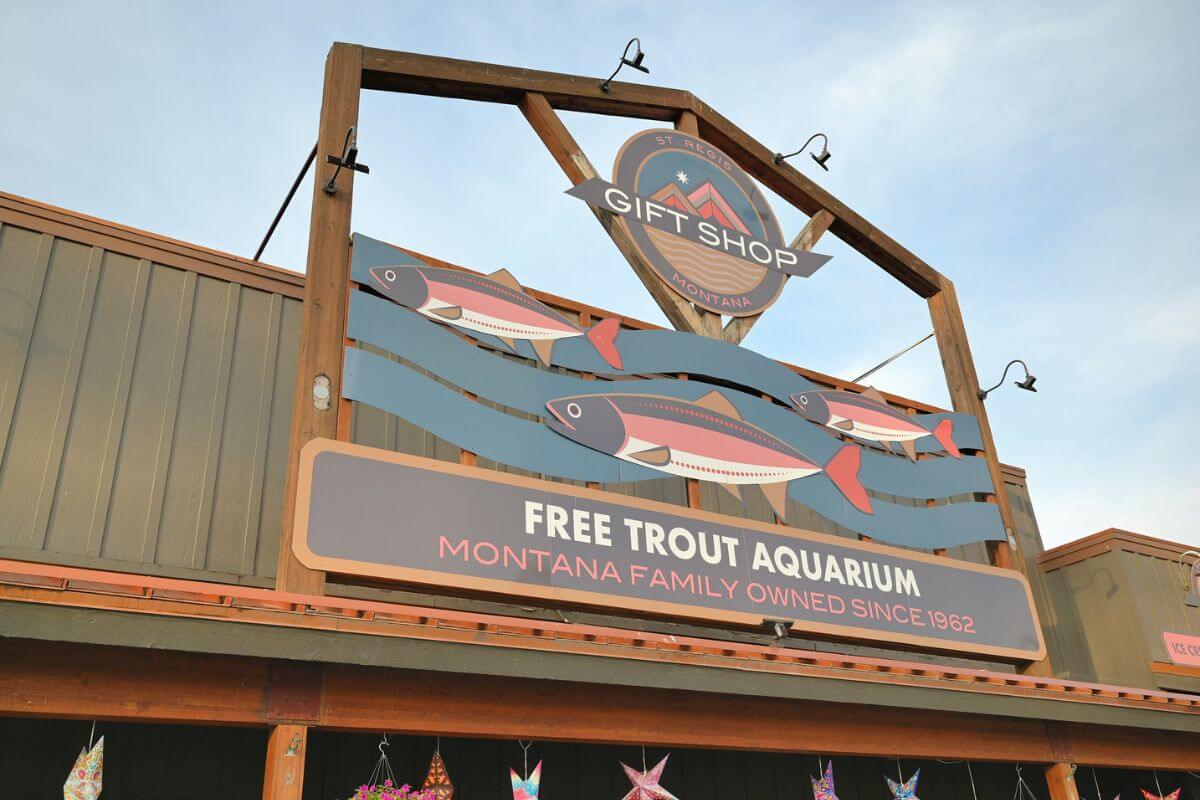
The St. Regis Trout Museum, located at the St. Regis Travel Center in western Montana, offers a unique and educational experience for visitors interested in exploring the diverse trout species of the region.
If you’re on the lookout for Montana aquariums, this one should have you covered. While not your traditional zoo or marine exhibit, this museum provides an excellent opportunity to learn about Montana’s native trout.
At the heart of the museum are enormous fish tanks housing various species of the state fish. One distinctive feature is the opportunity for visitors to enter one of the tanks through a low opening, immersing themselves in an environment surrounded by trout.
Inside the museum, visitors can marvel at the four primary species of trout showcased:
- Brown Trout – Known for its olive-green color with red and black spots, brown trout are prized by anglers for their fighting spirit and inhabit cold, clear streams worldwide.
- Brook Trout – With vibrant red, orange, and yellow patterns, brook trout prefer the cool, clean waters of small streams and mountain lakes across North America.
- Cutthroat Trout – Featuring distinctive red slashes beneath their lower jaw, cutthroat trout inhabit various freshwater habitats and play a significant role in western fly fishing history.
- Rainbow Trout – Renowned for their iridescent pink stripe, rainbow trout thrive in freshwater habitats and are prized by anglers for their acrobatic jumps and strong fights.
The aquariums are fed from an artesian well, ensuring pristine water conditions maintained at a chilly 45 degrees, optimal for the trout’s health.
The St. Regis Trout Museum isn’t just about observing fish; it also provides basic trout education, making it a valuable stop for families and enthusiasts alike. Many families have made visiting the museum a tradition during their trips to the area.
Moreover, the St. Regis Travel Center offers a range of amenities, including a restaurant, casino, convenience store, and fuel stop, making it a convenient and entertaining destination for travelers passing through.
Best of all, the museum is a free attraction, open 24/7, allowing visitors to enjoy and learn about Montana’s native trout species at their leisure. Whether you’re a seasoned angler or simply curious about the aquatic life of Montana, the St. Regis Trout Museum promises an enriching experience for all.
ZooMontana and Other Montana Zoos Final Thoughts
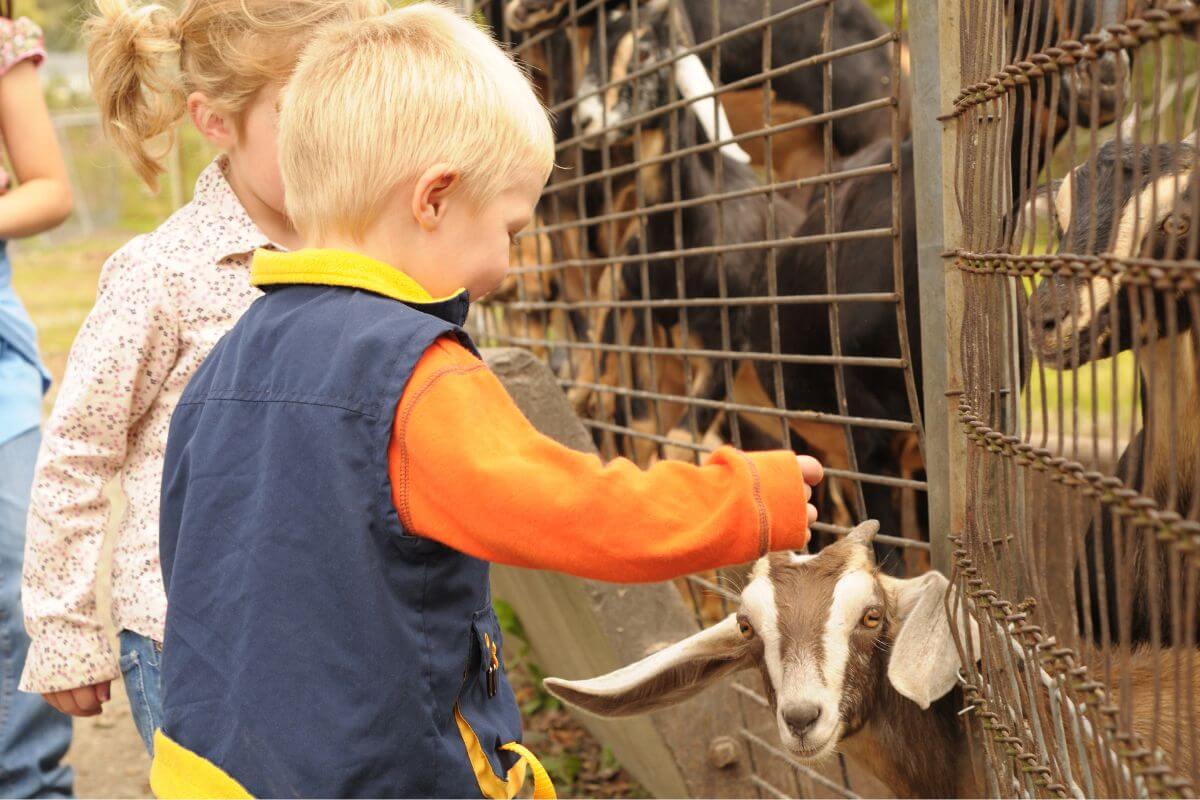
ZooMontana is a dedicated wildlife conservation hub located in Billings, Montana with a diverse collection of over 100 animals spanning 51 species, emphasizing rescues.
The educational initiatives at ZooMontana include direct observation, interpretive displays, and experiential programs, providing visitors with a unique opportunity to explore the Yellowstone ecosystem fauna.
The significant impact of community and educational programs reaches over 12,000 students and 100,000 visitors annually, showcasing ZooMontana’s pivotal role in fostering awareness and appreciation for wildlife.
The well-designed animal exhibits, divided into regions like Asia and North America, offer a journey through diverse habitats. The integration of botanical elements enhances the visitor experience and emphasizes the interconnectedness of flora and fauna.
Alongside other Montana attractions such as the Grizzly and Wolf Discovery Center and St. Regis Trout Museum, ZooMontana represents a vital intersection of education, conservation, and community involvement. They encourage everyone to participate in the crucial mission of preserving and valuing our planet’s rich biodiversity.
ZooMontana and Other Montana Zoos FAQs
1. How Many Zoos Are There in Montana?
ZooMontana stands as the sole zoo and botanical park in Montana, spanning over 70 acres. This unique wildlife park hosts a variety of animals, representing different species, each residing in habitats crafted to emulate their natural environments.
2. What Is the Largest Zoo in Montana?
ZooMontana in Billings is considered the largest zoo in Montana. This zoological and botanical facility boasts a diverse collection of over 100 animals representing 51 different species and encompasses both animal exhibits and extensive botanical gardens.
3. Is There an Entrance Fee at Zoo Montana?
Yes, there is an entrance fee at Zoo Montana. The admission prices are as follows: $9.00 for Adults, $8.00 for Children aged 3-15, and $11.00 for Military personnel. Additionally, there are special rates for school and nonprofit groups, with a fee of $4.00 per person for such groups.
Fascinated by this subject? Dive deeper into Montana with these recommended articles:

